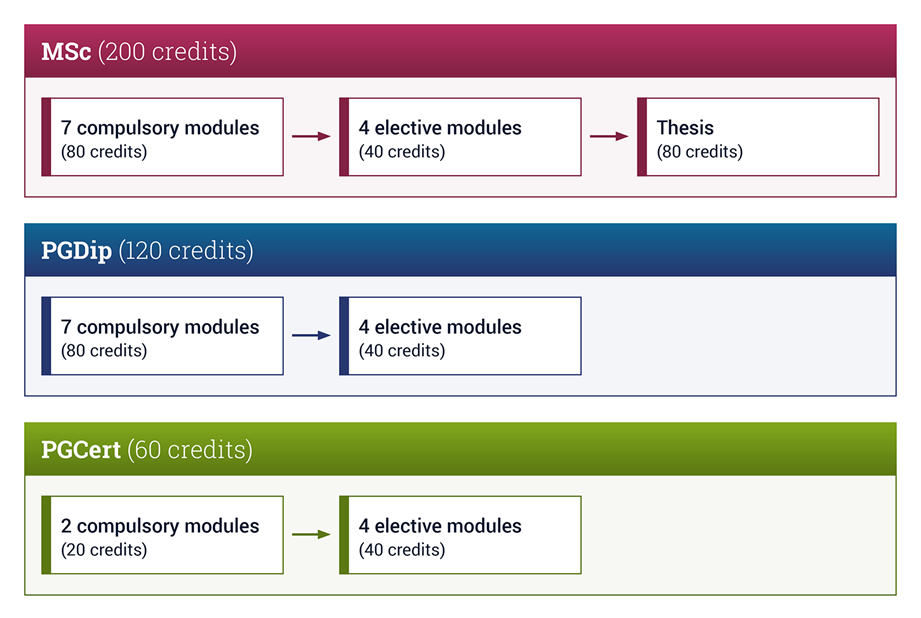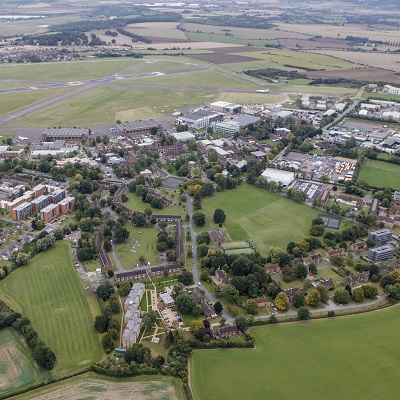This part-time course meets the requirements of the Level 7 System Engineering Master's Apprenticeship. Eligible organisations will be able to use their Apprenticeship Levy to cover the cost of the course tuition fees. View Fees and Funding information, or find out more about Master's Apprenticeships.
Overview
- Start date23rd September 2024
- DurationMSc: up to three years part-time; PgDip: up to two years part-time
- DeliveryBlended learning
- QualificationMSc, PgDip
- Study typePart-time
- CampusCranfield campus
Who is it for?
- Experienced and/or qualified engineers, scientists, managers or leaders wishing to broaden and deepen their skills or apply them in systems engineering or related roles.
- Recent graduates wishing to extend their knowledge and skill within systems engineering professional roles.
Why this course?
The Centre for Systems Engineering has been at the forefront of developing systems engineering education for the past fifteen years, blending the breadth of systems thinking with the rigour of systems engineering and closely integrating this within acquisition management.
The course has been set up to enable students better understanding to focus content and delivery on systems engineering professionals working in distributed, agile teams using shared models and flexible working approaches, with an emphasis on professional skills such as leadership, team working, communication, data management and ethics.
The MSc in Systems Engineering is designed for those seeking Professional status in their chosen career. A PgDip (two years) is usually the minimum qualification used for mapping to the UKSPEC.
However, the University recognises that personal circumstances may change and as such there is a possible exit route after one year’s successful completion of study, of a PgCert in Systems Engineering.
Institute for Apprenticeships - Systems Engineering Degree
Course details
The course is modular and you will accumulate credits for each module you successfully complete (10 credits per module). The thesis is worth 80 credits.
The course structure has been devised to give the maximum amount of flexibility for you to create your own learning pathway whilst ensuring that the fundamental principles of systems engineering are compulsory.
Course Structure
Course delivery
Blended learning
Individual project
The Individual Project provides you with an opportunity to undertake an in-depth study of an area of particular interest to you or your sponsor which is written up as a thesis or dissertation. The study might include, for example:
- Application of systems engineering tools and techniques to a real-world problem,
- Analysis of underpinning systems engineering theory and practice,
- Development of new or tailored systems engineering processes.
Modules
Keeping our courses up-to-date and current requires constant innovation and change. The modules we offer reflect the needs of business and industry and the research interests of our staff and, as a result, may change or be withdrawn due to research developments, legislation changes or for a variety of other reasons. Changes may also be designed to improve the student learning experience or to respond to feedback from students, external examiners, accreditation bodies and industrial advisory panels.
To give you a taster, we have listed the compulsory and elective (where applicable) modules which are currently affiliated with this course. All modules are indicative only, and may be subject to change for your year of entry.
Course modules
Compulsory modules
All the modules in the following list need to be taken as part of this course.
Introduction to Systems and Systems Engineering
| Module Leader |
|
|---|---|
| Aim |
|
| Syllabus |
Unit 1: Systems Science
Unit 2: Systems Thinking
Unit 3: SE Life Cycle
United 4: Systems Modelling
|
| Intended learning outcomes |
On successful completion of this module you will be able to:
|
System Design and Realisation
| Module Leader |
|
|---|---|
| Aim |
|
| Syllabus |
Unit 1: System design,
Unit 2: Trade Studies,
Unit 3: Integration, Verification and Validation,
Unit 4: Through life support,
Unit 5: Logistics, obsolescence and system retirement,
Unit 6: Other considerations: Acceptance, training, impact of organisational role allocations, |
| Intended learning outcomes |
On successful completion of this module you will be able to:
|
System Definition
| Module Leader |
|
|---|---|
| Aim |
|
| Syllabus |
Overview of early Life Cycle management and how SE Concept and System Definition are related in a Model Based approach, Overview of Logical Architecture and Requirements theory and models. Unit 2: Model Based SE (MBSE), Introduction to the System Modelling Language (SySML), Overview of the course MBSE methodology. Unit 3: Model Based System Definition - Requirements System Requirements Process outcomes and activities, Using MBSE models to define System of Interest Functions and Requirements, Unit 4 Requirements Management, Principle of Good Requirements Specification and Review. Unit 5: Model Based System Definition - Architecture: Logical System Architecture Process outcomes and activities, Using architecting notations to define Logical Architectures (LA), iterations between LA, Physical Architecture and Mission Analysis. Unit 6: Module Workshops, Apply Requirements and LA models in a group student project, Discussion of MBSE Benefits and Challenges. Note, for the SEE module these units are covered in weeks 1-6. For the SESD they are delivered over a 5 day residential timetable, with workshops each day. |
| Intended learning outcomes |
On successful completion of this module you will be able to:
|
Systems Thinking in Practice
| Module Leader |
|
|---|---|
| Aim |
|
| Syllabus |
Unit 1: Problem Exploration
Unit 2: Concept Definition: Mission Analysis (MA)
Unit 3: Reflection |
| Intended learning outcomes |
On successful completion of this module you will be able to:
|
Enterprise Systems Engineering
| Module Leader |
|
|---|---|
| Aim |
Successful integration and practice of systems engineering within a business environment requires a wider knowledge and understanding of the strategic management and business processes of the organisation and wider enterprise. Spanning a wide range of individual disciplines, enterprise management is used to ensure that all business activity is planned, managed and delivered to achieve strategic aims, objectives and goals. The interdisciplinary nature and wide-ranging applicability of systems engineering means there are inevitable touch points and integration requirements to ensure the enterprise can continue to deliver and meet its overarching goals and requirements. This module critically examines the relevance of underpinning theories and practice across the enterprise management domain from a systems engineering perspective. Taking a capability- and effects-based context, it aims to provide the systems engineer with extended knowledge of the wider business environment within which the systems lifecycle sits, and how systems engineering application itself requires systems thinking and practice to successfully integrate it within wider business and management processes and approaches |
| Syllabus |
Unit 1 – Enterprises, Architectures and Lifecycles
Unit 2: Strategy and Mission Analysis
Unit 3 – Operations Management and Systems Engineering
Unit 4 – Capability Management and Stakeholder Needs
Note, for the SEE module these units are covered in weeks 1-6. For the SESD they are delivered over a 5 day residential timetable, with workshops each day. |
| Intended learning outcomes |
On successful completion of this module you will be able to:
|
Systems Engineering Workshop
| Aim |
|
|---|---|
| Syllabus |
|
| Intended learning outcomes |
On successful completion of this module you will be able to: Knowledge,
Skills,
|
Research Methods
| Module Leader |
|
|---|---|
| Aim |
This module is foundational to the MSc Systems Engineering, which demands the multi-perspective, multi-methodological approach to research taught in this module because of the range of both research questions which can be, and are, addressed in systems engineering research to inform the body of knowledge of the discipline. In addition, a distinctive perspective which we take in our approach to systems engineering is that systems engineering in a process of research to find the appropriate solution to needs, itself demanding a broad range of research methods to provide a foundation of assured knowledge to base project work upon through any and all phases of the system lifecycle.
Therefore, this module is a core module of the MSc because the learning achieved will be applied in both the academic setting (the MSc thesis, and possible later studies) and also in the practice of systems engineering in the various workplace setting in which course students and graduates will work. |
| Syllabus |
Unit 1: Knowledge, novelty and verification and validation,
Unit 2: Areas of interest and research questions,
Unit 3: Framing research projects,
Unit 4: Quantitative methods,
Unit 5: Modelling and simulation method,
Unit 6: Formative feedback re proposed research methodology,
Unit 7: Writing about research: Proposals, reports, theses, and papers, |
| Intended learning outcomes |
On successful completion of this module you will be able to:
|
Thesis
| Module Leader |
|
|---|---|
| Aim |
To conduct a self-directed piece of research applying the principles, practices and processes developed in the course to a real world problem of interest and relevance to the student. |
| Syllabus |
|
| Intended learning outcomes |
On successful completion of this module you will be able to:
|
Elective modules
One of the modules from the following list need to be taken as part of this course
Software and Cyber Systems Engineering
| Aim |
|
|---|---|
| Syllabus |
Unit 1: Software Engineering and Systems Engineering,
Unit 2: System Analysis and Modelling,
Unit 3: Software Architectures and Models,
Unit 4: Cyber Systems and Security,
Unit 5: Integration and Testing,
Unit 6: Other Considerations, |
| Intended learning outcomes |
On successful completion of this module you will be able to:
|
Megaproject Systems
| Module Leader |
|
|---|---|
| Aim |
Megaprojects are large, complex projects that typically have a value of above $1Bn. Once considered rarities, megaprojects are not only large, but growing constantly larger and are being constructed in ever greater numbers. From high-speed rail to modern major defence projects, or from staging the Olympics to implementing national 5G communications networks, megaprojects affect our normal everyday lives and can impact millions of people. What sets megaproject systems apart from more traditional system is not just their size but their complexity and scope – megaprojects often straddle public and private sector boundaries and are intrinsically linked to the general public. This means that technological, political, economic and societal aspects all coalesce and play an important role - both overtly and covertly – to system success. This module explores the realm of megaproject systems and expands the traditional systems engineering approaches, thinking and methods to identify and address the complexity and closer integration of hard engineering, design, management and social sciences within a single entity. |
| Syllabus |
Unit 1 – The Megaproject Engineering Mindset
Unit 2 – Planning and Delivery
Unit 3 – Towards the Boundary and Beyond: Context
Unit 4 – Accounting for Change |
| Intended learning outcomes |
On successful completion of this module you will be able to:
|
Life Cycle Cost and System Value
| Module Leader |
|
|---|---|
| Aim |
|
| Syllabus |
Value and utility – financial value and cost of systems and benefits provided in the application domain, Alternatives in design and engineering, Interest, compound interest, time value of money, Formulae for equivalent value over time. Unit 2: Methodology, Life cycle cost situation, Life cycle cost analysis, Cost over the life cycle, Estimating cost – methods analogy, parametric methods, accounting, data, reference class forecasting. Unit 3: Errors in estimation and sensitivity analysis, Errors in estimation – methods to describe, Sensitivity analysis – single and multiple alternatives, Monte Carlo analysis and applications. Unit 4: Additional Factors Affecting Decisions, Depreciation (real and book value), Taxation effects on analysis, Projects with no financial return (typically government asset and service provision), Inflation. Unit 5: Application to complex System Planning, Optimisation of investment decisions, Planning of fleet size, Economic life calculations. Unit 6: System Life Cycle Events, Effect of change of scenario during life, Valuation of system resilience. |
| Intended learning outcomes |
On successful completion of this module you will be able to:
|
Dependability and Resilience
| Module Leader |
|
|---|---|
| Aim |
|
| Syllabus |
The concepts of function, failure, fault and defect in the context of reliability, maintenance, maintainability, availability and resilience. Relationship of availability, reliability and maintainability and systems engineering, Contracting for availability, reliability and maintainability. Unit 2: Reliability and maintainability, Mechanisms of failure and their mathematical description, Concepts and introductory analysis of fault tree analysis, Corrective and preventive maintenance, Maintenance strategies to provide equipment repair, overhaul and Through Life Support, Level of Repair Analysis, Failure Modes Effects and Criticality Analysis. Unit 3: Availability, Measures of availability, Intrinsic Availability, Achieved Availability, Operational Availability, Discussion of the relationship between the different views of availability in the three measures. Unit 4: Introduction to Resilience, Overview of resilience, Concept of threat, Time phases of resilience: before, during, after threat events, Type A and Type B threats, Active and latent threats, Relationship of resilience and other specialty engineering fields. Unit 5: Resilience Schools of Thought (1) Hollnagel School of Thought based on safety and organisational response, Protection School of Thought focused on identifying high impact threats and providing methods to protect from their effect. Unit 6: Resilience Schools of Thought (2) Engineering for Resilience through use of design heuristics, Measurement of resilience – diverse approaches to measurement of resilience and the implied definition and view of resilience. |
| Intended learning outcomes |
On successful completion of this module you will be able to:
|
Human Systems Engineering
| Module Leader |
|
|---|---|
| Aim |
Provide students with an understanding of the challenges raised by the consideration of humans in systems, and the tools and techniques for considering human system issues across the SE life cycle as part of a Model Base SE approach. |
| Syllabus |
Review of system, human-machine system and systems engineering, Overview of human factors contribution in systems engineering, Introduction of some key terminologies, HF, HFE, ergonomics, HFI and HSI and the history of their development. Unit 2: Human Considerations in Engineering, Overview of human factors areas that need considerations in Engineering System The application of human factors in rail and highway industry, The application of human factors in defence industry. Unit 3: Human Cognitive Aspects and Organisational and Cultural Issues, Overview of human cognitive aspects in complex socio-technical systems, Overview of cultural and organisational behaviour aspects in complex socio-technical systems, Overview of human requirements. Unit 4: Human Factors Methods, Human factors methods and tool and their relationship with systems engineering, Human factors methods for supporting human systems engineering, Systems engineering methods for supporting human systems engineering. Unit 5: Human Factors in the SE Life Cycle, A general discussion of the mapping HF Methods to the SE life Cycle, Suggested generic HF activities and views, as part of the MBSE methodology presented earlier in the module, Example of the HF extension to the MBSE methodology. Unit 6: Human Factors Integration to SE Workshop, The application of SE methods, including MBSE, for supporting Human Systems Engineering, The application of HF methods integration into the SE life cycle for supporting Human Systems Engineering. |
| Intended learning outcomes |
On successful completion of this module you will be able to:
|
Dynamic Modelling of Systems
| Module Leader |
|
|---|---|
| Aim |
|
| Syllabus |
Dynamical systems, complexity and change. Closed systems and their behaviour. Structure as a driver of dynamic behaviour. Building candidate understanding models and testing them. Reference modes. The "twin pillars" of SD – feedback thinking and computational modelling. SD as a paradigm to support systems thinking, Unit 2: Qualitative SD, Seeing complexity as an emergent consequence of cause and effect. Visualising the interdependencies within complex systems using feedback structures and causal loop diagrams. Considering policy interventions as points of leverage. Developing understanding of complex systems and communicating it usefully. Relationship to other soft methods, Unit 3: Quantitative SD, Simulating feedback systems. First order, second order and higher order feedback systems. Suggesting and testing policy interventions for behavioural improvement. Theoretical underpinnings of SD modelling, including its background in control theory. Introducing delays. Formulating equations, using data and estimating parameters. Relationship to other computational simulation methods, Unit 4: Implementing the SD approach, Building useful models. Verification and validation of simulation models. Case studies and a detailed modelling exercise. |
| Intended learning outcomes |
On successful completion of this module you will be able to:
|
Simulation in the Systems Engineering Lifecycle
| Aim |
|
|---|---|
| Syllabus |
• The fundamental concepts of simulation modelling and how simulation is used in the SE lifecycle. • The theoretical basis of quantitative modelling • The role of modelling in supporting decision making. Unit 2: Appreciation of Modelling in the SE Context • Model types; discrete and continuous, stochastic and deterministic. • Model appropriateness: the verification and validation of models, data considerations, model fidelity • Model interoperability and networking. Unit 3: Introduction to Modelling Paradigms • Discrete event simulation • System dynamics modelling • Agent based models • Virtual reality Unit 4: Model building and analysis • Introduction to simulation methods and tools • Simulation as experimentation. |
| Intended learning outcomes |
On successful completion of this module a student should be able to: 1. Evaluate the role of simulation modelling in the successful realization of systems 2. Critically evaluate the issues surrounding the use of simulation models in the systems engineering lifecycle. 3. Appreciate the key benefits and risks associated with a number of modelling paradigms. 4. Build and analyse simple models using a range of methodologies. |
Complex Adaptive Systems
| Module Leader |
|
|---|---|
| Aim |
As products, services and solutions become ever more detailed and interconnected in their nature, ideas of complexity become ever more important in understanding the structure and behaviour of these artifacts. Moreover, as these artifacts are required to alter and adapt to changes in requirement, use and context, it is important that a means to allow them to be adapted as rapidly as possible is considered during their development and use lifecycle. Therefore, the idea of Complex Adaptive Systems (CAS) is necessary to meet the challenges in developing and supporting products, services and systems in an ever-changing world. This module will consider CAS in the context of current industrial and consumer need and appraise how SE methods and methodologies such as Agile can be used to describe, characterise, and implement them. This will be placed within the context of the systems lifecycle. |
| Syllabus |
Examine the nature of complexity in systems, Analyse the meaning of complex adaptive systems and consider the different forms that they might take, Appraise how systems engineering can facilitate the development and support of CAS. Unit 2: Complex Adaptive Systems Thinking, Evaluate how a complex adaptive system (CAS) can be characterised and described within representative business and enterprise contexts, Evaluate how SE methods and tools can help characterise CAS. Unit 3: Complex Adaptive Systems and Agile, Evaluate the worth, strengths and weaknesses of Agile methodologies such as SCRUM and SAFe in facilitating CAS, Apply agile methods to a representative case study, Reflect on the use of agile methods. Unit 4: Design for Complex Adaptive Systems (DfCAS), Analyse what is needed to institute a design philosophy that will support the development and implementation of CAS, Create a logical architecture to support DfCAS for a representative case study, Reflect on the extent to which architectures can be made reconfigurable. Unit 5: Through Life Planning, Evaluate the effect of Complex Adaptive Systems (CAS) on Through Life Systems Engineering and Management (TLSEM), Devise a representative systems lifecycle for CAS. |
| Intended learning outcomes |
On successful completion of this module you will be able to:
|
Teaching team
You will be taught by Cranfield's leading experts with capability expertise, industry knowledge and collective subject research, as well as external speakers from industry and defence. The Course Director is Steve Barker. The teaching team includes:
Your career
Takes you on to impressive career prospects across a range of roles commensurate with your experience. This includes membership of multidisciplinary teams in acquisition, supply or research organisations. This could be in both general systems engineering roles or as a focal point for specific skills such as availability, reliability and maintenance (ARM), human factors, requirements, architecture test and evaluation etc. It is also applicable to key roles in MoD acquisition such as project team leader, capability manager and requirements manager.
Cranfield Careers and Employability Service
Cranfield’s Careers and Employability Service is dedicated to helping you meet your career aspirations. You will have access to career coaching and advice, CV development, interview practice, access to hundreds of available jobs via our Symplicity platform and opportunities to meet recruiting employers at our careers fairs. We will also work with you to identify suitable opportunities and support you in the job application process for up to three years after graduation.
How to apply
Click on the ‘Apply now’ button below to start your online application.
See our Application guide for information on our application process and entry requirements.














